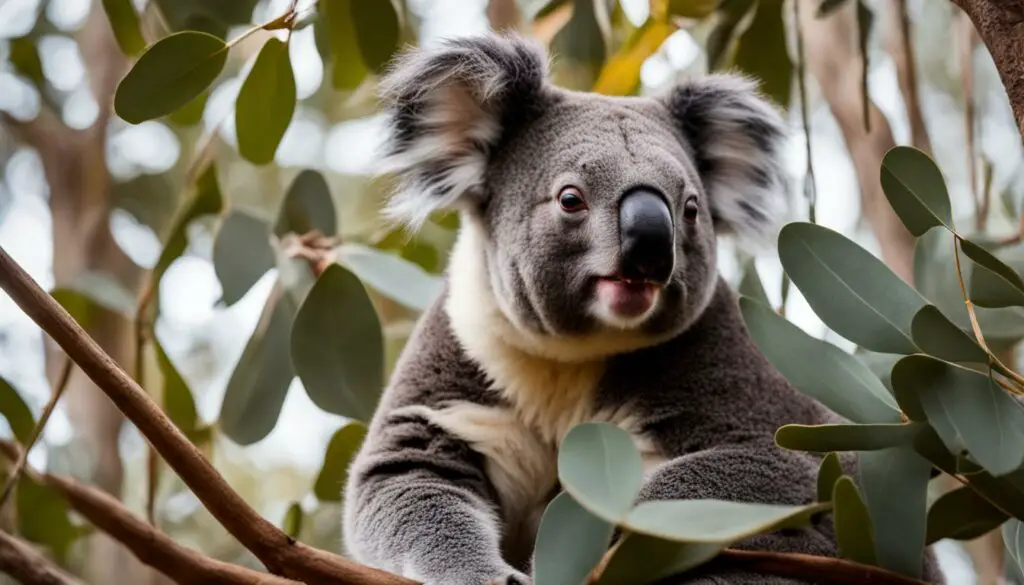Koalas are a beloved and iconic species, known for their cuddly appearance and unique vocalizations. However, these adorable creatures are facing numerous challenges in their struggle for survival. Habitat loss, disease, and climate change are threatening their existence in the wild, pushing them closer to the brink of extinction.
In this article, we will explore the important topic of koala captive care and the various challenges they face. We will delve into the essential aspects of koala husbandry, including their dietary needs, enclosure design, and enrichment activities. Additionally, we will shed light on the vital role of health monitoring and disease management in ensuring their well-being.
Through this discussion, we hope to raise awareness about the critical issues surrounding koala conservation and the dedicated efforts being made to protect these remarkable creatures.
Koala Husbandry and Care in Captivity
Koala husbandry in captivity plays a vital role in ensuring the well-being and conservation of this iconic species. Proper care involves providing a suitable diet, designing appropriate enclosures, and implementing enriching activities. The focus is on replicating their natural habitat and stimulating their innate behaviors to ensure their physical and mental health.
Proper Diet
The foundation of koala care in captivity lies in providing them with a diverse and nutritious diet. While eucalyptus leaves form the bulk of their diet, it is crucial to offer a variety of eucalyptus species to meet their nutritional needs. This helps mimic their natural foraging behavior and ensures they receive the necessary nutrients for their well-being. Conservation organizations work closely with experts to develop feeding plans that cater to individual koalas’ dietary requirements.
Enclosure Design
Koalas in captivity require enclosures that closely resemble their natural habitat. This includes providing ample climbing opportunities and suitable resting spots, such as trees and platforms. The enclosures should be spacious enough to allow for exercise and movement. The design also takes into consideration temperature regulation, ensuring koalas can find comfort in both warm and cool conditions. Additionally, enclosures should offer privacy to reduce stress and promote a sense of security.
Enrichment Activities
To promote the mental and physical well-being of koalas in captivity, enrichment activities are essential. These activities aim to simulate their natural behaviors, ensuring they remain engaged and stimulated. Puzzle feeders, for example, encourage problem-solving skills and stimulate their natural foraging behavior. Scent enrichment, on the other hand, involves introducing new scents to their environment, providing sensory stimulation and mimicking their encounters with other koalas in the wild.
By focusing on husbandry practices that prioritize proper diet, enclosure design, and enrichment activities, captive koalas can lead fulfilling lives and contribute to conservation efforts. Conservation organizations continue to collaborate with experts to further refine and improve these practices, ultimately ensuring the long-term survival and well-being of this beloved species.
Koala Health Monitoring and Disease Management
Ensuring the health and well-being of captive koalas is vital for their long-term care. Regular health monitoring is a crucial aspect of captive koala management. Routine check-ups, physical examinations, and diagnostic tests help detect any signs of disease or health issues early on, allowing for prompt intervention and treatment.
Koalas are particularly susceptible to diseases like chlamydia, which can cause severe complications such as infertility and blindness. To effectively manage these diseases, a comprehensive approach is necessary. This includes the use of antibiotics, vaccinations, and quarantine protocols to prevent the spread of infectious diseases within the captive population.
“Regular health monitoring is essential for captive koalas to ensure early detection and treatment of diseases.”
Providing specialized medical care for captive koalas requires a knowledgeable veterinary team and well-equipped facilities. These professionals work closely with caretakers and conservation organizations to develop tailored healthcare plans and implement best practices in disease management.
| Benefits of Health Monitoring | Actions |
|---|---|
| Early detection of diseases | Regular check-ups and diagnostic tests |
| Prevention of disease spread | Quarantine protocols and vaccinations |
| Timely treatment | Prompt intervention and use of antibiotics |
By implementing comprehensive health monitoring and disease management strategies, captive koalas can receive the care they need to thrive in a protected environment. This ensures their well-being while also contributing to the conservation of the species as a whole.
Koala Breeding Programs and Conservation Efforts
Koala breeding programs and conservation efforts are crucial for the long-term survival of this iconic species. These programs aim to ensure genetic diversity and repopulate devastated forests, ultimately working towards safeguarding the future of koalas.
In captive breeding programs, koalas are carefully selected for breeding based on their genetic makeup and suitability for release. The goal is to produce offspring that can be reintroduced into the wild, thus contributing to the recovery of fragmented populations. These programs require extensive planning, coordination, and collaboration between zoos, conservation organizations, and government agencies.
Koala conservation efforts extend beyond breeding programs. Habitat restoration plays a vital role in creating suitable environments for koalas to thrive. This involves reforesting areas with eucalyptus trees and establishing wildlife corridors to connect fragmented habitats. By creating a network of connected habitats, koalas have access to food sources and can safely move between areas, enhancing their chances of survival.
Public education and awareness campaigns are also essential components of koala conservation efforts. By raising awareness about the challenges faced by koalas and the importance of their conservation, individuals are empowered to take action. These campaigns often highlight the impact of deforestation, climate change, and disease on koala populations, encouraging individuals to support conservation initiatives and make environmentally friendly choices.
Table: Overview of Koala Breeding Programs
| Breeding Program | Main Objectives | Key Achievements |
|---|---|---|
| Queensland Koala Crusaders | Boost koala populations in Queensland | Released over 100 koalas into suitable habitats |
| Conservation Volunteers Australia | Engage volunteers in koala conservation | Planted over 10,000 eucalyptus trees in koala habitats |
| Taronga Conservation Society Australia | Monitor and study koala behavior | Contributed valuable research insights into koala social dynamics |

By combining captive breeding programs, habitat restoration, and public education, we can make a significant impact on the conservation of koalas. Each individual effort contributes to the collective goal of ensuring a future where these unique and beloved animals continue to roam their natural habitats.
Conclusion
In conclusion, koalas face numerous challenges in captivity, including habitat loss, disease, and the impacts of climate change. However, through dedicated conservation efforts, there is hope for their survival. To ensure the long-term well-being of koalas, it is crucial to focus on key aspects of their care and conservation.
Firstly, protecting and restoring their habitats is paramount. By preserving and creating suitable environments, we can provide koalas with the resources they need to thrive. This includes planting food trees, establishing wildlife corridors, and educating the public about the importance of koala conservation.
Secondly, effective husbandry and care practices are essential for the well-being of captive koalas. Providing a varied and nutritious diet, designing suitable enclosures that mimic their natural habitat, and implementing enrichment activities to keep them mentally and physically engaged are all crucial components of their care.
Furthermore, ongoing health monitoring and disease management are imperative. Regular check-ups, diagnostic tests, and the use of antibiotics and vaccinations help maintain the health of captive koalas. Having a knowledgeable veterinary team and specialized facilities ensures that they receive proper medical care.
Lastly, koala breeding programs and conservation efforts play a vital role in safeguarding the species. By carefully selecting release sites and monitoring the health and behavior of released koalas, we can contribute to repopulating devastated forests and maintaining genetic diversity.
With continued efforts and public support, we can work together to protect these iconic animals. By prioritizing koala captive care, conservation efforts, and rehabilitation initiatives, we can ensure a brighter future for koalas and secure their long-term survival.
What specific challenges do koalas face in captivity and how are they cared for to address these challenges?
Koalas face challenges in captivity due to their specialized diet and stress. To address this, caregivers provide eucalyptus as their main food source and create a stress-free environment with minimal human interaction. Fun facts about koala bears: they sleep up to 22 hours a day and have fingerprints similar to humans.
FAQ
How are koalas cared for in captivity?
Koalas in captivity are provided with a proper diet consisting mainly of eucalyptus leaves. Their enclosures are designed to mimic their natural habitat, with trees for climbing and resting, and space for exercise. Enrichment activities such as puzzle feeders and scent enrichment are implemented to stimulate their natural behaviors.
What challenges do koalas face in captivity?
Koalas in captivity face challenges such as habitat loss, disease, and climate change. Regular health monitoring is essential to detect any signs of disease, and disease management includes the use of antibiotics and vaccinations. Breeding programs are crucial for maintaining genetic diversity and ensuring their long-term survival.
How is the health of captive koalas monitored?
Regular health monitoring of captive koalas involves routine check-ups, physical examinations, and diagnostic tests. This helps detect any signs of disease or health issues early on. Koalas are susceptible to diseases like chlamydia, and proper disease management protocols are in place to prevent the spread of infectious diseases.
What efforts are being made to conserve koalas?
Conservation efforts for koalas include protecting and restoring their habitats, establishing wildlife corridors, and educating the public about their importance. Breeding programs aim to introduce captive-born koalas to the wild, helping repopulate devastated forests. Public awareness and support are crucial for the success of these conservation initiatives.
What is being done to ensure the long-term survival of koalas?
Conservation efforts focus on habitat restoration, wildlife corridors, and public education to raise awareness about the importance of koala conservation. By protecting and restoring their habitats, implementing effective husbandry practices, monitoring their health, and implementing breeding programs, there is hope for the long-term survival of this iconic species.










